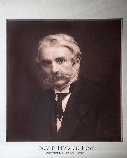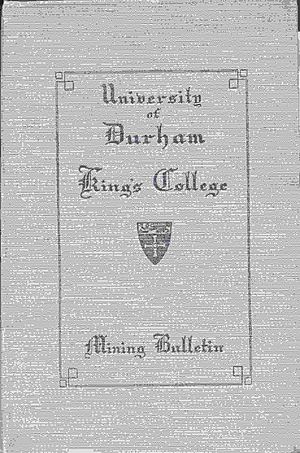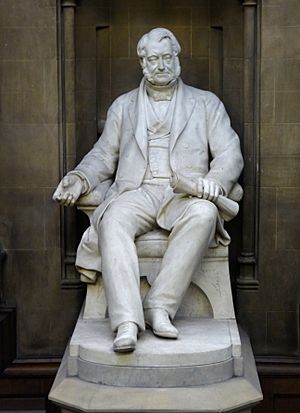Edward Fenwick Boyd facts for kids
Quick facts for kids
Edward Fenwick Boyd
|
|
|---|---|
| British | |

Edward Fenwick Boyd
|
|
| Born | 30 August 1810 Moor House, Leamside, County Durham, England
|
| Died | 31 August 1889 (aged 79) Durham, England
|
| Spouse(s) | Ann Anderson |
| Children | 4 children, Juliana Fenwick Boyd, George Fenwick Boyd, Robert Fenwick Boyd and Hugh Fenwick Boyd |
| Parent(s) | William Fenwick Boyd, Esther Fenwick Boyd (née Locke) |
Edward Fenwick Boyd (born August 30, 1810 – died August 31, 1889) was an important English businessman. He was a leader in the mining industry. He became the fourth President of the North of England Institute of Mining and Mechanical Engineers (NEIMME). This group helps make mining safer and better. Edward Boyd helped start the Institute in 1852. He was its Treasurer and a council member. Later, in 1869, he became its president. While he was president, he helped build the Nicholas Wood Memorial Hall. This hall became the main office for the Mining Institute in Newcastle upon Tyne. He also helped create the Newcastle College of Physical Science.
Contents
Edward Boyd's Early Life
Edward Fenwick Boyd was born on August 30, 1810. His birthplace was Moor House in Leamside, Durham. He was the third son of William Boyd, who was a banker. His mother was Esther Boyd.
Edward went to school at Witton-le-Wear Grammar School for five years. He started there in 1821. He was very good at art during his school years. After school, he began working in coal mines. He worked at Cocken White House Pit and then at Bowes’ House Pit. There, he met Thomas Crawford, a manager of large coal mines.
From 1830 to 1831, Edward studied at Edinburgh University. He also kept working in the mining industry. After university, he traveled with Matthias Dunn. Dunn was a mine inspector. They visited many coal mines in Scotland.
In 1832, Edward got his first job as an underviewer and surveyor. This was at Hetton-le-Hole Colliery. In 1837, he moved to Urpeth. He became the manager of Urpeth Colliery. He also managed Wylam Colliery for the Blackett family.
Edward Boyd's Family Life
As Edward's career grew, so did his personal life. In 1841, he married Ann Anderson. They soon started a family. Between 1846 and 1852, they had four children. Their names were Juliana, George, Robert, and Hugh.
In 1856, Edward bought Moor House, where he was born. He built a new home there for his family. He planned to take life easier. However, a financial problem in 1857 changed his plans. A bank failed, and he lost his savings and inheritance.
With a young family to support, Edward had to start over. He continued his old jobs and took on many new ones. This became the busiest time of his life. In 1858, he became the Chief Mining Engineer for the Consett Iron Company. He managed their coal mines until 1872.
Starting the Mining Institute
Mining accidents were a big problem in the past. For example, an explosion at St Hilda’s Colliery in 1839 showed how dangerous mining could be. Miners and others realized they needed a group to help prevent such disasters. They wanted better rules and aims for the mining community.
People suggested new ideas to make mines safer. These included keeping records of mine plans. They also wanted government inspections. It was also suggested that women and children should not work underground. Better scientific education for Mining Engineers was also needed.
In 1850, new laws were passed. Coal mines had to have inspectors. They also had to keep mine plans. All deadly accidents had to be reported to the government.
Another explosion, at Seaton Colliery in 1852, led to the creation of the NEIMME. Important leaders like Nicholas Wood and Edward Sinclair were involved. They joined 44 coal mine owners. Together, they started "The North of England Society for the Prevention of Accidents".
Later, the society changed its name to "The North of England Institute of Mining Engineers". In 1870, it became "The North of England Institute of Mining & Mechanical Engineers". The main goals were to find out what caused mining accidents. They also wanted to make mines safer. This included improving how mines were ventilated.
Edward Boyd played a very important part in starting this Institute. He was known for being reliable. So, he was chosen as the Treasurer from the very beginning until 1869. He also worked closely with Nicholas Wood, the first President. They worked on creating a school system for Mining Engineers.
Edward's hard work led to him being chosen as the fourth President of the NEIMME in 1869. As president, he worked hard on opening the Nicholas Wood Memorial Hall. This hall became the main home for the Mining Institute. He also continued Nicholas Wood's work to create the College of Physical Science.
Creating the College of Physical Science
One of Edward Boyd’s biggest achievements was helping to start the College of Physical Science in 1871. This college later became Newcastle University. Many leaders believed that education was very important for mining engineers. Mining was becoming more difficult and dangerous as mines went deeper. So, training and professional skills were essential.
Nicholas Wood had an idea for a three-year course. It would focus on practical and industrial training. They hoped the college would be independent. However, because of high costs, this was not possible. So, it was decided the college would be connected to Durham University.
The university would pay for two professors. One would teach mathematics and natural philosophy. The other would teach applied mechanics. The college itself needed three more professors. These would teach Chemistry, Geology, and Mine Working. Miners needed to raise money for the building and the other professors' salaries. This first attempt did not raise enough money, so the project was stopped for a while.
After Nicholas Wood died, the next two presidents did not restart the project. It was Edward Fenwick Boyd who brought it back to life. He strongly believed in the importance of education. He argued that workers needed good guidance. Managers, he thought, would encourage good habits and education.
Boyd worked with the Dean of Durham University, William Lake (Dean of Durham). He had been part of earlier talks about the college. But he felt those talks failed because of disagreements. The main problems were where to put the college and how to get enough money.
Luckily, when Boyd was president, trade was doing well. There was a high demand for skilled young people in the area's industries. With more money and a need for training, Boyd believed the community would support the college. He thought education would "improve the community" and help the nation's success.
Boyd, with help from Lowthian Bell, tried again to get the college in Newcastle upon Tyne. A committee was formed in 1869. They met with leaders from Durham University. Many private talks happened between Lake, Boyd, and Bell. They reached a basic agreement.
In 1871, a public meeting was held in Newcastle. Lake offered £1000 per year for six years from Durham University. This was to help start the college in Newcastle. This was if a similar amount could be found from other sources. The offer was accepted. The committee decided to ask the public for £30,000. They wanted the college to open as soon as possible, in October 1871.
In its first year, the college had eight teachers and 173 students. It taught Mathematics, Physics, Chemistry, and Geology. More subjects were added later.
At first, the college did not offer Mining Engineering as a separate subject. They believed practical experience was as important as classroom learning. Many important people talked about how important it was to educate mining engineers. They also spoke about the benefits of Physical Science. The Dean of Durham said that teaching Physical Science helps people observe and ask questions. It also helps connect ideas to real facts about nature.
Professor John Young from the University of Glasgow also spoke about mining engineers. He said they needed to know about minerals and how to find them. They also needed mechanical skills to get minerals out of the earth. He said they should be geologists, mineralogists, and civil engineers. Because of this, Mining Engineering was later added to the college's courses.
Opening the Nicholas Wood Memorial Hall
Edward Boyd's time as president also included the opening of the Nicholas Wood Memorial Hall. This hall was built in 1870. It was a tribute to Nicholas Wood, the first President of the Mining Institute. He had died in 1865.
The hall officially opened in July 1872. Edward Fenwick Boyd, the Dean of Durham, and the Mayor of Newcastle were all there. Many other town council members also attended.
The hall was built mainly for coal traders and mining engineers in the North of England. It has been the home of the Mining Institute ever since. It was designed in a style called Gothic revival. Inside, there is a large marble statue of Nicholas Wood. He is shown sitting and looking over the library.
Today, the hall is still important for education. It holds many old documents, maps, and books from the Institute's start in 1852. A lecture theatre was added in 1902. It is used for talks and lectures about the mining industry.
Edward Boyd's Later Years
Edward Boyd's presidency ended in 1872. But he stayed involved with the Institute. He remained a member of the council until 1882.
In 1875, he worked with his son, Robert Fenwick Boyd. They wrote a paper about coal and oil in the United States of America. They traveled to the U.S. to gather information for this paper. This was Edward's last work presented to the Mining Institute.
After this, he focused on being a magistrate for the county. A magistrate is like a judge who handles smaller legal cases. He spent the rest of his time working on law and county business.
In 1883, his health began to get worse. He had to retire and return to Moor House. He stopped all his work in the court and at the Institute. His daughter took care of him until he died on August 31, 1889.
Edward Fenwick Boyd's work, especially opening the College of Physical Science and the Nicholas Wood Memorial Hall, was very important. These projects show how dedicated he was to the North of England Institute of Mining and Mechanical Engineers.
Images for kids






